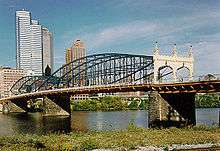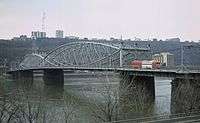Smithfield Street Bridge
| Smithfield Street Bridge | |
|---|---|
 Smithfield Street Bridge | |
| Carries |
4 lanes of roadway 2 pedestrian walkways |
| Crosses | Monongahela River |
| Locale | Pittsburgh, Pennsylvania |
| Characteristics | |
| Design | Lenticular truss bridge |
| Total length | 1,184 feet (361 m) |
| Longest span | 2 spans, 360 feet (110 m) each |
| Clearance below | 42.5 feet (13.0 m) |
| History | |
| Opened | March 19, 1883 |
|
Smithfield Street Bridge | |
   | |
| Location | Smithfield St. at the Monongahela River, Pittsburgh, Pennsylvania |
| Coordinates | 40°26′5″N 80°0′8″W / 40.43472°N 80.00222°WCoordinates: 40°26′5″N 80°0′8″W / 40.43472°N 80.00222°W |
| Area | 1 acre (0.40 ha) |
| Built | 1883 |
| Architect | Gustav Lindenthal |
| Architectural style | Other, Romanesque, Pauli truss |
| NRHP Reference # | 74001745[1] |
| Significant dates | |
| Added to NRHP | March 21, 1974 |
| Designated NHL | May 11, 1976[2] |
| Designated CPHS | February 22, 1977[3] |
| Designated PHLF | 1970[4] |
The Smithfield Street Bridge is a lenticular truss bridge crossing the Monongahela River in Pittsburgh, Pennsylvania, USA.
The bridge was designed by Gustav Lindenthal, the engineer who later designed the Hell Gate Bridge in New York City. The Smithfield Street Bridge was built between 1881 and 1883, opening for traffic on March 19, 1883.[5] It was widened in 1889 and widened again in 1911. The bridge has been designated a National Historic Civic Engineering Landmark, a National Historic Landmark, and has a Historic Landmark Plaque from the Pittsburgh History and Landmarks Foundation.
History
The present bridge is the third bridge at the site and remains the second oldest steel bridge in the United States. In 1818, a wooden bridge was built across the Monongahela by Louis Wernwag at a cost of $102,000. This bridge was destroyed in Pittsburgh's Great Fire of 1845. The second bridge on the site was a wire rope suspension bridge built by John A. Roebling. Increases in both bridge traffic and river traffic eventually made the lightly built bridge with eight short spans inadequate. The present Lindenthal bridge was built in its place, using the Roebling bridge's stone masonry piers.
The Smithfield Street Bridge is the penultimate of the many bridges which span the Monongahela before the river joins with the Allegheny River to form the Ohio River at Downtown Pittsburgh. The Fort Pitt Bridge is further downstream of it.
The bridge also served the Pittsburgh Railways streetcar system with lines coming from the Mt. Washington Transit Tunnel and from Carson Street crossing the bridge and continuing into downtown along Grant Street and Smithfield Street, returning to the bridge via Wood Street or Grant Street. The tracks occupied the eastern half of the bridge. The streetcar line was abandoned in July 1985, when the streetcars were diverted to the Panhandle Bridge and the new light rail subway, on July 7.[6] The last day of streetcar service on downtown Pittsburgh streets and over the Smithfield Street Bridge was July 6, 1985, although the final crossing of the bridge by a streetcar did not take place until 1:40 a.m. on July 7.[7] The former streetcar right-of-way was then converted into a paved roadway for northbound traffic.
The bridge was listed on the National Register of Historic Places on March 21, 1974. Two years later, on May 11, 1976, it was designated a National Historic Landmark.[2]
The bridge's short clearance from the river as well as its deteriorated condition convinced PennDOT officials to demolish the bridge and to replace it with a modern bridge. Lobbying by Pittsburgh History and Landmarks Foundation on the merits of preserving the bridge were considered by officials. In 1994–1995 the bridge was rehabilitated with a new deck, a colorful paint scheme, and architectural lighting. The abandoned rail lines became an extra traffic lane and there was an addition of a light-controlled bus lane which is activated during peak traffic hours.[8] The bridge also has the distinction of being the most heavily walked pedestrian bridge, mostly commuters that park at Station Square.
The bridge connects Smithfield Street in Downtown Pittsburgh with Station Square.
Image gallery
 View from downtown in 1984, with a streetcar leaving the bridge
View from downtown in 1984, with a streetcar leaving the bridge A streetcar crossing the bridge in 1966, southbound.
A streetcar crossing the bridge in 1966, southbound. Detail of the ironwork on the Smithfield Street Bridge, looking south.
Detail of the ironwork on the Smithfield Street Bridge, looking south. The Smithfield Bridge at dusk
The Smithfield Bridge at dusk North end, in the 2000s
North end, in the 2000s
Popular culture
The bridge is featured in the 1993 Bruce Willis film Striking Distance, the opening scene of the 1983 film "Flashdance" and the 2010 rap video Black and yellow.
See also
| Wikimedia Commons has media related to Smithfield Street Bridge. |
- List of bridges documented by the Historic American Engineering Record in Pennsylvania
- List of crossings of the Monongahela River
- Mount Washington Transit Tunnel
References
- ↑ National Park Service (2010-07-09). "National Register Information System". National Register of Historic Places. National Park Service.
- 1 2 "Listing of National Historic Landmarks by State: Pennsylvania" (PDF). National Park Service. p. 5. Retrieved June 29, 2014.
- ↑ "Local Historic Designations". Pittsburgh: Pittsburgh History & Landmarks Foundation. Retrieved 2011-08-09.
- ↑ Historic Landmark Plaques 1968-2009 (PDF). Pittsburgh, PA: Pittsburgh History & Landmarks Foundation. 2010. Retrieved 2010-07-02.
- ↑ "Bridges and Tunnels of Allegheny County - Historic American Engineering Record Smithfield Street Bridge, Pittsburgh (PA-2)". 1974. Retrieved November 7, 2009.
- ↑ Grata, Joe (July 7, 1985). "PennDot ponders future use of Smithfield Street Bridge". The Pittsburgh Press. p. A9.
- ↑ Sellin, M.V. and Morgan, S.J. (May 1986). "Pittsburgh light rail progess". Modern Tramway and Light Rail Transit, p. 164. UK: Ian Allan Publishing.
- ↑ Carquinez Associates, U.S. Urban Rail Transit Lines Opened From 1980
External links
- Historic American Engineering Record (HAER) No. PA-2, "Smithfield Street Bridge, Spanning Monongahela River on Smithfield Street, Pittsburgh, Allegheny County, PA", 28 photos, 2 color transparencies, 44 data pages, 4 photo caption pages
- Smithfield Street Bridge on pghbridges.com
- American Society of Civil Engineers on Smithfield Street Bridge
- Historical photos of the bridge from the Carnegie Library of Pittsburgh
- A collection of contemporary photos of the bridge
- Smithfield Street Bridge (1846) at Structurae
- Smithfield Street Bridge (1883) at Structurae

